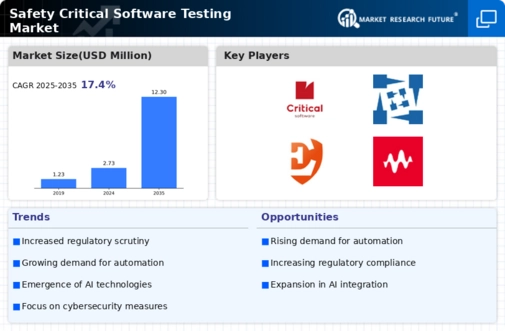By Region, the study provides market insights into North America, Europe, Asia-Pacific and Rest of the World. The demand for safety critical software testing can be seen significantly high in North America as the U.S. is the largest producer of high-technology manufacturing which includes the production of aircraft, spacecraft, automotive and many more. The top key players in the aerospace and defense industry are located here. Lockheed Martin Corp, Raytheon Technologies Corp, The Boeing Co, General Dynamics Corp, and Northrop Grumman Corp are the top 5 aerospace and defense companies in the US.
Innovations in areas such as advanced avionics, stealth technology, and space exploration drive ongoing investment and growth. The U.S. maintains a strong military presence globally and upgrades to its aerospace and defense capabilities. The region being advanced in technology across aerospace and defense, the demand for safety critical software testing is more. Safety-critical industries, such as healthcare, aerospace, automotive, and energy, are more dependable on sophisticated software systems. As software plays a more central role in these sectors there is a growing demand for testing technologies in north America with all the well-established sectors in this region.
Europe has the most technologically advanced countries like Germany, Switzerland, United Kingdom, Sweden and other. Germany owns the world’s most significant car production factories like Volkswagen, BMW, and Mercedes-Benz. This nation is a frontier in the automotive technology sector. Apart from electric vehicles (EVs), it also consists of facilities that are involved in technologies such as autonomous driving and advanced manufacturing process. German companies such as Siemens and Bosch are leaders in industrial automation and robotics.
This automotive industry targets the safety-critical systems and follows rigorous standards for their functional safety—for instance, ISO 26262—through developing and validating systems like anti-lock braking, traction control, and adaptive cruise control.
APAC countries such as Japan, China and India are highly recognized in the aerospace sector. In AI research and application, China stands out among some of the largest contributors. Safety-critical software testing with artificial intelligence, for instance, is becoming increasingly important for anomaly detection methods, as well as formal verification or fault simulation techniques. Testing done in China follow national standards like GB—Guobiao standards—industry specific guidelines. Active AI technologies have been integrated into the COMAC’s testing and validation processes for its C919 aircraft. This includes predicting maintenance using artificial intelligence, detecting anomalies, and modeling various flight scenarios with it.
China is also growing rapidly within its medical technology manufacturing sector while being a dominant player in telecommunications too.
Digital transformation drives growth in the MEA region's software testing market. Since more and more MEA businesses are turning toward digital, there is an increasing need for robust software testing to ensure quality standard. Saudi Arabia’s Vision 2030 and the UAE’s National Innovation Strategy include substantial investments in IT and software solutions hence driving demand for robust software testing. DevOps techniques are being applied by UAE firms such as Etisalat and du in product or software development and deployment. Al-Futtaim Motors and Emirates Motor Company, among other automobile companies based in UAE, conduct rigorous software testing.
The Dubai Health Authority is the governing body that takes care of the testing of medical devices, which are in compliance with the standard of ISO 13485, along with IEC 62304. This testing includes validation and verification processes to ensure the functionality and safety of the devices.
The adoption of smart technologies is increasing at a fast pace in several sectors of South America. Most of the technologies involve safety-critical software that requires rigorous testing for reliability and safety. Government initiatives and investments in technology and infrastructure also play an important role for the demand of safety critical software testing.Argentina’s aerospace industry has been growing with advancements in both commercial and defense aerospace technology. Brazilian regulations and standards for automotive safety are becoming more stringent which necessitate comprehensive software testing to ensure compliance. Standards such as ISO 26262 for functional safety are crucial for automotive software development.
FIGURE 3: SAFETY CRITICAL SOFTWARE TESTING MARKET VALUE BY REGION 2024 and 2035 (USD Million)

Source: Secondary Research, Primary Research, Market Research Future Database, and Analyst Review
Further, the countries considered in the scope of the Safety Critical Software Testing Market are the US, Canada, Mexico, UK, Germany, France, Italy, Spain, Switzerland, Austria, Belgium, Denmark, Finland, Greece, Hungary, Italy, Luxembourg, Netherlands, Norway, Poland, Portugal, Slovakia, Sweden, Romania, Ireland, China, Japan, Singapore, Malaysia, Indonesia, Philippines, South Korea, Hong Kong, Macau, Singapore, Brunei, India, Australia & New Zealand, South Africa, Egypt, Nigeria, Saudi Arabia, Qatar, United Arab Emirates, Bahrain, Kuwait, and Oman, Brazil, Argentina, Chile, and others.
















Leave a Comment